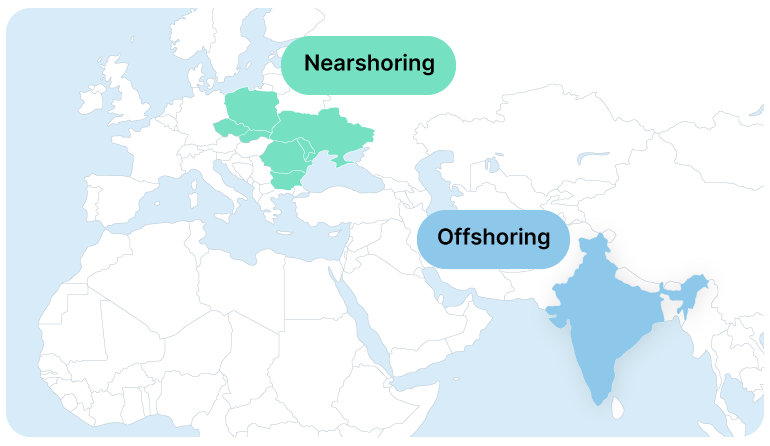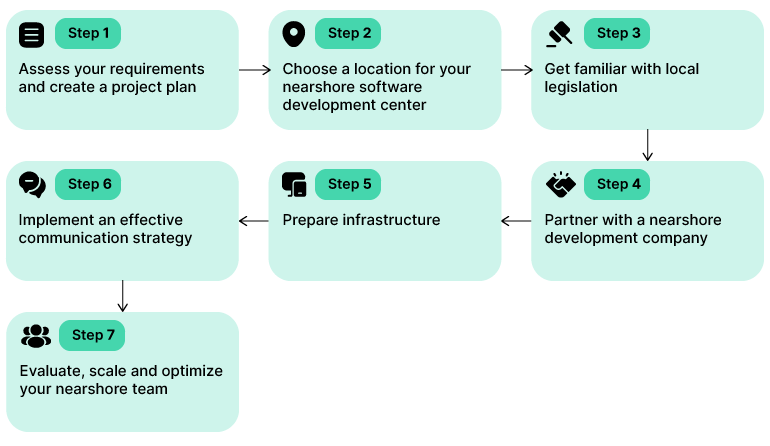The advance of cloud technologies and online platforms has erased borders for recruiters in software development. In the past, businesses were restricted to the talent pool in their geographic area. Now, they can recruit developers from around the world. Seeking the ideal combination of quality, professionalism, and cost-effectiveness, many companies favor an outsourcing model to meet their IT needs. This demand is driving a steady increase in the size of the software outsourcing market. According to Statista, it is projected to grow by more than 50% from 2020 to 2029, reaching US$271.7 billion.
Obvious benefits of outsourcing include cost savings due to local market dynamics, lower infrastructure costs, and access to a wider talent market. Particular outsourcing models may offer different benefits, increasing flexibility in setting up an effective work process. From the geographic point of view, the two main outsourcing models are offshoring and nearshoring.
Offshoring means partnering with a development team or company in a country on a different side of the globe (usually, on another continent). With nearshoring, your partner is located next door, usually in a neighboring country.

A cross between offshoring and working with a domestic business, nearshoring is often regarded as a nearly perfect model of collaboration, as it allows achieving multiple goals. Moving development to a country with a different economic environment can allow you to take advantage of lower hourly rates, reducing overall costs. At the same time, having a technology partner in a neighboring country means you are in the same (or a close by) time zone and ensures a similar culture between your in-house and outsourcing teams.
Now, what if you are planning not only a single project but a larger initiative with an extensive scope? What if you need to maintain more than one outsourcing team? What if you want to secure a permanent presence in another country? All of these challenges may have a single solution – establishing a nearshore development center.
Establishing your own nearshore development center vs partnering with a service provider
A nearshore development center is located in a country near yours and hires development talent in their local market. In setting up a nearshore software development center, you can go the path of establishing your own nearshore center from the ground up, or you can partner with a local development company that will become your nearshore development services provider and use its premises and workforce.
While owning a development hub in a neighboring country can provide better security (we do recommend this option for high-security projects!), hiring an established service provider in your chosen nearshoring destination has a number of advantages:
| Setting up your own nearshore software development center | Hiring an established nearshoring service provider | |
|---|---|---|
| Investment | High – including property lease and infrastructure setup | Lower – the service provider usually offers its own premises and infrastructure for a nearshore development center. |
| Speed of launch | Slow – you need to set up a physical facility and hire talent required for the project. | Fast – your development partner already has a facility and experts with the necessary skills on board. |
| Scalability | Lower – additional investment needed for premises, hardware, tools, and personnel needed for the project expansion. | Higher – minimal additional investment required and fast recruitment with access to skills via your partner’s talent pool |
| Security | Highest – you establish your own procedures and practices and control their execution | High – you verify your partner’s security practices and implement your own procedures if needed |
| Risk level | High – risk directly related to the amount of investment | Lower – your partner shares responsibilities for the project with you. |
7 steps to build a successful nearshore software development center
Like any initiative, creating a nearshore development center requires an action plan. Let’s look at the main steps you should take when getting ready to launch your nearshore collaboration.
Step 1. Assess your requirements and create a project plan
Start by outlining your expectations from a nearshore development center and setting clear goals you plan to achieve. List the technologies and skills you are looking for, define the scope of your project and its timeline, plan the budget, and set success criteria. Having a clear plan helps to accelerate the launch and increase predictability.
Step 2. Choose a location for your nearshore software development center
Depending on where your main business is located, you can choose one of several regions that are popular for nearshoring:
- For the USA or Canada, check out nearshoring destinations in Latin America. You can partner with high-quality software development companies in Brazil, Argentina, Colombia, Mexico, and other Latin American countries.
- For the EU, look at countries in Eastern and Central Europe. You will find a good balance of cost and quality in Ukraine, Poland, or Romania. As an alternative, consider nearshoring to Portugal, home to many highly qualified developers, where hourly rates are lower than in Western Europe.
Step 3. Get familiar with local legislation
Whether you are planning to establish your own nearshore development center or hire a local company in your nearshoring destination, you need professional legal advice about the local laws. If you are setting up your own facility, you will need to register a legal entity, get a tax ID number, hire personnel, obtain necessary permits, and maintain ongoing legal compliance.
If you are partnering with a service provider in the nearshore country, you will still need to understand and adhere to local tax and compliance regulations to make sure your collaboration is in line with all the legal requirements.
Step 4. Partner with a nearshore development company
In choosing your nearshoring partner, focus on the availability of skills and talent you need, rates, and, of course, reputation and expertise. You will have to contact many companies and hold many interviews and meetings, but, in the long run, you will be able to compare offers and select the one that suits you best.
When choosing a partner for a nearshore software development center, pay attention to the following criteria:
- Expertise of the candidates. Check out a candidate’s education, certifications, participation in similar projects (especially in the same domain), and English proficiency for effective communication.
- Infrastructure. If the company provides its own premises, pay attention to office maintenance, security, equipment and software provisioning, and overall workplace comfort.
- People management policies and procedures. You are about to start a long journey, and it is critical that your partner practices a retention-boosting approach to human resources.
- Cultural fit. Ensure that the team working at your nearshore development center is on the same wavelength as you and shares the same ethical and cultural principles.
- Experience with outsourcing services. The results of your collaboration may be better if your partner has a proven track record with any type of outsourcing services: team extension, dedicated teams, offshore or nearshore development.
- Customer satisfaction. For every company you are considering as a potential partner, look up publicly available reviews and ratings on Clutch, GoodFirms, or similar platforms. Browse each company’s website for case studies, client success stories and testimonials.
Step 5. Prepare infrastructure
To help your nearshore development center reach cruising altitude and start delivering value faster, make sure the team has everything they need. That includes both hardware and software that developers require for the project: PCs and laptops, software licenses, on-premises or cloud servers, data storage and backup, security tools, and so on.
For your own nearshore software development center, you will need to procure all the infrastructure yourself and budget all these initial investments. If you opt to partner with a local company, many of the things you need to get started will already be available, with only some specific tools to be provided for your project.
Step 6. Implement an effective communication strategy
Your nearshore software development center is a branch of your business, so it’s crucial to have proper communication in place from day one. Include your nearshore team in the communication network you use in your main business or set up a new network if both you and your team find it more efficient.
Choose a set of tools for instant messaging, audio and video calls and conferences, file sharing, and project management to enable effective collaboration. Many tools combine these functions. For example, you can use MS Teams or Slack for calls, messaging, and file sharing.
Step 7. Evaluate, scale and optimize your nearshore team
Introduce and track performance KPIs from the very beginning of your nearshore operations. Using measurable performance indicators will help you evaluate whether goals, timelines, and quality standards are being adhered to. At the same time, any deviations can suggest what needs to be improved. Be in constant contact with the team, encouraging constructive feedback, discussing issues and challenges, and recognizing success.
As your business grows, your nearshore team might need to grow, too. If you have set up efficient workflows and processes, it will be easier for you to expand the team, achieving optimal performance and productivity.

5 pillars for effectively setting up a nearshore development center
For your nearshore development center to meet your expectations, you need to launch it on a strong foundation of a clear vision and an actionable strategy. Here are a few tactics you might want to consider to secure the success of your nearshore operations.
1. Set clear goals
Understanding goals and expectations helps your nearshore team get off on the right foot. Goals help to align the team’s activities with the overall business strategy, placing them in the context of project timelines, costs, and definitions of success.
Based on your goals, your nearshore software development center team can better plan their everyday work, skill improvements, and career objectives, contributing to the project’s success.
2. Define processes and establish governance
Make sure that your nearshore development center works according to well-structured workflows, improving the team’s visibility into project goals and milestones. Efficient governance frameworks help to ensure clear accountability and mitigate potential risks.
At the same time, effective project governance improves the overall business reputation by enabling smooth work processes and predictable results.
3. Maintain integration with core teams
Your nearshore development center should function as a division of your main business. Therefore, it must be seamlessly integrated into all your processes. Include your nearshore team in company-wide activities, promote knowledge sharing, and build a common corporate culture across both in-house and nearshore facilities.
4. Create a comprehensive onboarding program
To empower your nearshore team to start delivering value within the shortest time, provide them with access to the company’s resources they need to get started and introduce them to established procedures. It may be a good idea to practice mentorship and coaching to help nearshore team members get familiar with your company’s internal processes.
5. Provide learning opportunities
Continuous learning is now a must in any technology company, nearshore or not. IT evolves at breakneck speed, producing new concepts, tools, platforms and – let’s face it – cyber threats with each passing year. Learning allows your employees to stay abreast of innovations and maintain your product’s high quality.
Another benefit of creating a productive learning environment is increased employee loyalty. Companies that invest in the professional growth of their employees have higher retention rates.

Intellias’s experience as an outsourcing and nearshoring services provider
As a potential nearshoring or outsourcing partner, Intellias covers all the bases.
Technology expertise – We have more than 3,000 software development experts with strong knowledge of the most popular programming languages and innovative technologies, including pioneering ones such as AI and ML, data management, and intelligent automation.
Geographic presence – Intellias has 14 delivery locations in Europe, North America and South America, which makes us an ideal vendor of nearshore development services for businesses in many countries.
Experience as an outsourcing services provider – In 20+ years of working in the IT services market, Intellias has partnered with many companies, sharing software engineering expertise in team extensions and offshore and nearshore outsourcing.
Quality of work – Hundreds of successfully completed custom software development projects for more than 150 clients speak for themselves.
Boost growth with a nearshore software development center
A well-executed nearshore strategy can become a quantum leap in your pursuit of quality, productivity, and cost-effectiveness. Establishing a nearshore development center in a nearby country gives you access to professional talent at a flexible cost. Additionally, a nearshoring partner should share a similar corporate culture and be able to collaborate seamlessly with your main team.
When launched and managed properly, nearshore software development centers become valuable assets, enhancing operations, expanding a company’s presence, and opening opportunities for engineering excellence. If you are planning a technology-intensive project and are looking for professional software development services at a reasonable cost, nearshoring is the right approach. Contact us and we will help you get started on your nearshoring journey.


